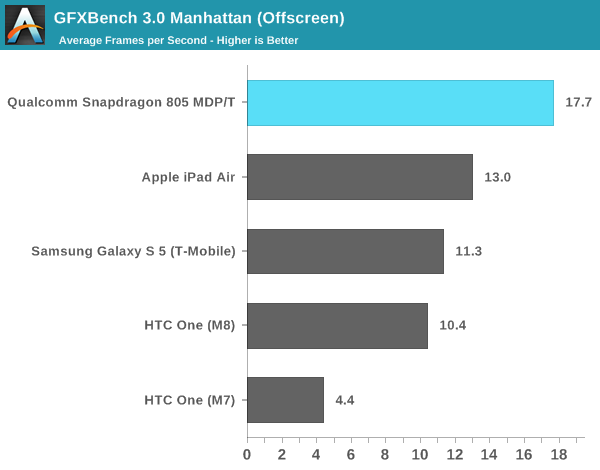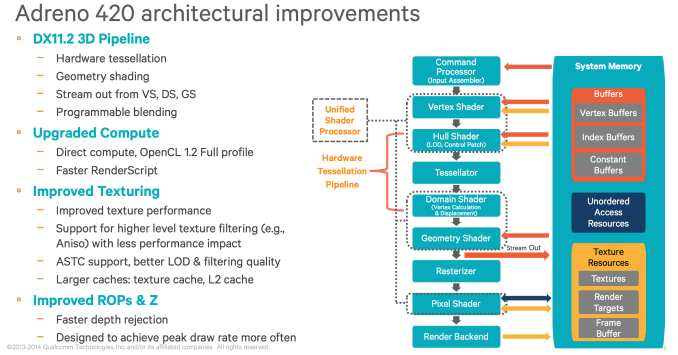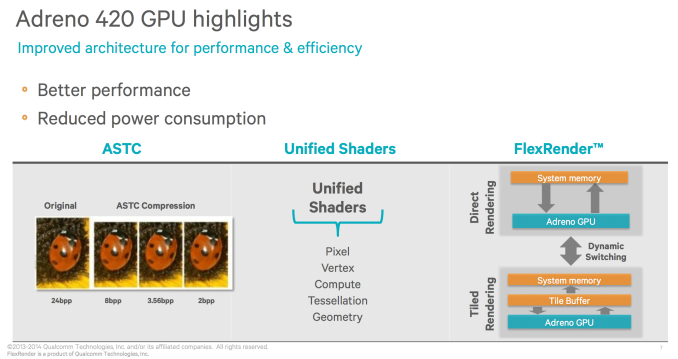Google I/O: Qualcomm Celebrates Launch of Adreno 420 GPU for Android Gaming
by Ryan Smith on June 23, 2014 1:00 PM EST
With Google’s annual I/O developers’ conference taking place this week, this should end up being a busy week for Android news. The conference itself doesn’t officially start until Wednesday the 25th this year, but several partners are already chomping at the bit to get going. First among these will be Qualcomm, who will be using the backdrop of the I/O conference to celebrate the launch of their latest high-performance SoC-class GPU, the Adreno 420.
Adreno 420 is the first member of Qualcomm’s next-generation SoC GPU family to make it out the door and in to a finished product, bringing with it OpenGL ES 3.1 and Direct3D 11 functionality. First announced last year as part of the Snapdragon 805 SoC, Snapdragon 805 and by extension Adreno 420 is now shipping in Samsung’s just-announced Galaxy S5 Broadband LTE-A. The S5B marks the first Adreno 420 product to reach consumer hands, and for as much as an SoC can have a formal launch this would be it, with Qualcomm celebrating its launch coinciding with this year’s Google I/O conference.
For Qualcomm the Adreno 420 in particular is an especially big deal since it is the first GPU to ship based on the Adreno 400 architecture. The Adreno 400 architecture marks a significant advancement in the feature set of Qualcomm’s GPUs, bringing Qualcomm’s latest architecture generally up to par with the existing desktop GPUs by integrating full Direct3D feature level 11_2 functionality alongside the more mobile-focused OpenGL ES 3.1 feature set. By doing so Qualcomm has reached feature parity with desktop GPUs (for the time being), even slightly exceeding NVIDIA’s GPUs by Direct3D standards due to being an FL 11_2 architecture versus NVIDIA’s FL 11_0 architecture.
As we have already covered Adreno 420 in some depth last month we won’t spend too much time going over it now, though admittedly this is also partially due to the fact that Qualcomm is remaining tight lipped about the Adreno 400 architecture beyond a high-level feature standpoint. In brief the Adreno 400 architecture (and Adreno 420) is a full Direct3D FL 11_2 implementation, utilizing a unified shader architecture along with the appropriate feature additions. New to the Adreno 400 architecture is support for tessellation, including the necessary hull and domain shader stages, and as a Direct3D 11 product this would also include with it other Direct3D 11 features such as compute shaders and draw indirect support.
Meanwhile on the OpenGL ES side of matters, while ES 3.1 is not as expansive as Direct3D 11, this none the less means that the Adreno 400 architecture brings with it ES 3.1 functionality along with a number of its Direct3D-derrived features as extensions. Mobile developers will also be happy to hear that this is the first Qualcomm product to support adaptive scalable texture compression (ASTC), the OpenGL next-generation compression technology that should further improve, unify, and simplify the use of compressed textures on mobile platforms.
For Google I/O we are expecting Qualcomm to be heavily promoting the Android gaming possibilities of the Adreno 420 and the Snapdragon 805. The low power nature of mobile devices and the SoCs that power them means that while Qualcomm can’t match the performance of the larger desktop GPUs, Adreno 420 will be a big step up from the performance offered by the older Adreno 330 GPU. But more importantly for Qualcomm, they can do something that hasn’t been done before by bringing desktop-level features to Android devices.

From our May 2014 Snapdragon 805 Preview
In a sense this will be a repeat of the launch of Direct3D 11 on the desktop, except now with Qualcomm (and eventually other vendors) promoting the advanced features offered by these devices, throwing out examples and tools at developers to entice them to write games for this latest generation of hardware, and to otherwise put it to good use. Even without being able to match desktop processors, there are a number of effects that are made available (or at least more practical) via these new features, and can be used effective on mobile hardware. From a practical perspective Qualcomm should be able to offer Android developers the base graphics functionality of the current generation consoles at performance levels similar to the previous generation consoles.
Source: Qualcomm












65 Comments
View All Comments
grahaman27 - Monday, June 23, 2014 - link
Both nvidia and Qualcomm say their mobile chips will support DX 12. The way I see it, qualcomm's only advance is that it will be included in nearly ever phow. Nvidia's k1 supports full opengl 4.4, tesselation, along with nvidia specific features that are used in desktop games.ravyne - Monday, June 23, 2014 - link
Devices with lower feature levels will be able to support D3D12, just like lower feature-level devices can support D3D11.K1 is Kepler-based, and therefore feature-level 11_0, which is still great for a mobile GPU.
nVidia Maxwell, as appears in the Geforce 750 and 750ti, and is the basis for next-gen nVidia GPUs, is feature-level 11_2; otherwise, nVidia's recent GPUs have all been 11_0. AMD's GCN 1.1, as in the 290/290x and 260/260x, are feature-level 11_2, and GCN 1.0 (7970, 280x) are 11_1.
The article is a bit mistaken that they've beaten nVidia to feature-level 11_2 support, because of the 750 and 750ti.
mczak - Monday, June 23, 2014 - link
Maxwell (at least gm107) still appears to be feature level 11_0 only.TheJian - Friday, June 27, 2014 - link
How important is a directX discussion in an OpenGL android/iOS world anyway? I don't quite get what they're bragging for about dx. They think winrt will become a hot commodity or something? Isn't 11.2 support win8.1+ only? I can understand why and gpu designer would ignore that market.http://www.guru3d.com/news_story/directx_11_2_anno...
If guru3d's statements are wrong now someone give a link please (not directed at you grahaman27). They also note it's running on a 770, so if it can't do 11.2 why use it (it at least does tiled resources part)?
http://msdn.microsoft.com/en-us/library/windows/ap...
8.1 required it seems. So again, I'd ask Qcom, "who cares?"
http://www.pcper.com/reviews/Graphics-Cards/NVIDIA...
PCper maxwell doesn't support 11.2
http://www.pcmag.com/article2/0,2817,2453551,00.as...
PCmag, maxwell DOES support 11.2...LOL.
"The GTX 750 Ti supports DirectX 11.2 and OpenGL 4.4, and 16 lanes of PCI Express 3.0."
RE: the regular 750 "It also supports DirectX 11.2 and OpenGL 4.4, and 16 lanes of PCI Express 3.0." well, hmmm...
Don't really care who's right, 8.1 is a not important to me (ever). Devs won't use it's features unless they backport them to win7 or win9 is a HUGE hit, which I have my doubts as they seem hellbent on just doing more of the same again.
OpenGL ES3.1 (most important on mobile) and OpenGL4.4 I'd think are far more important than bragging about dx11_2 which if used on mobile would bring you down to under 30fps for sure.
I still haven't seen games that REQUIRE Qcom hardware even from their snapdragongaming page. Every one I checked doesn't mention them at all or any optimizations specifically for them unlike Tegra THD games which will show unique effects etc on tegras.
https://www.youtube.com/watch?v=afFb2JU45gA&ht...
outerra engine demo running OpenGL3.3 appearing to do the same crap as dx11.2?
http://www.outerra.com/wfeatures.html
I really don't get why anyone is talking dx anything for mobile. Android doesn't use is last I checked, and nobody cares about MS on mobile (ok, a small few do). Considering NV owns 65% of discrete (and these are gamers) I don't see 11.2 as an issue anyway. MS used a 770 in their dx11.2 demo so whatever is missing can't be that bad (I've read just 2d crap isn't 11.2 but the 3d stuff is, but who knows). If I read correctly the tiled resources can be done on 11_0 and 11_1 hardware (maybe explains 770 doing it in the demo). Again though, who cares about DX when using android or iOS for what 95% of the world of mobile?
Voltism - Monday, June 23, 2014 - link
It's only fair the 420 gpu has blazing speeds and high benchmarksextide - Monday, June 23, 2014 - link
bhahaha lol ^^lkb - Tuesday, June 24, 2014 - link
Given its sheer amount of Rasta operation units, the blazin speed should be justified.AnandTechUser99 - Monday, June 23, 2014 - link
This is definitely a nice leap for Qualcomm, but Tegra K1 is still quite a bit more powerful.GFXBench 3.0 Manhatten (Offscreen):
Xiaomi MiPad (Tegra K1 32-bit version) - 28.1 Fps
Qualcomm MDP/T (Snapdragon 805) - 17.7 Fps
Apple iPad Air (A7) - 13.0 Fps
Flunk - Monday, June 23, 2014 - link
The question is, does which has bettery power consumption and does the K1 include baseband. Because the point is mute if the power consumption is terrible and it will never make it into phones without built-in baseband.jwcalla - Monday, June 23, 2014 - link
I doubt we'll see TK1 in many phones. Tablets and Chromebooks and purpose-built Android gaming devices are a different story though.I think nvidia has pretty much given up on the phone market.